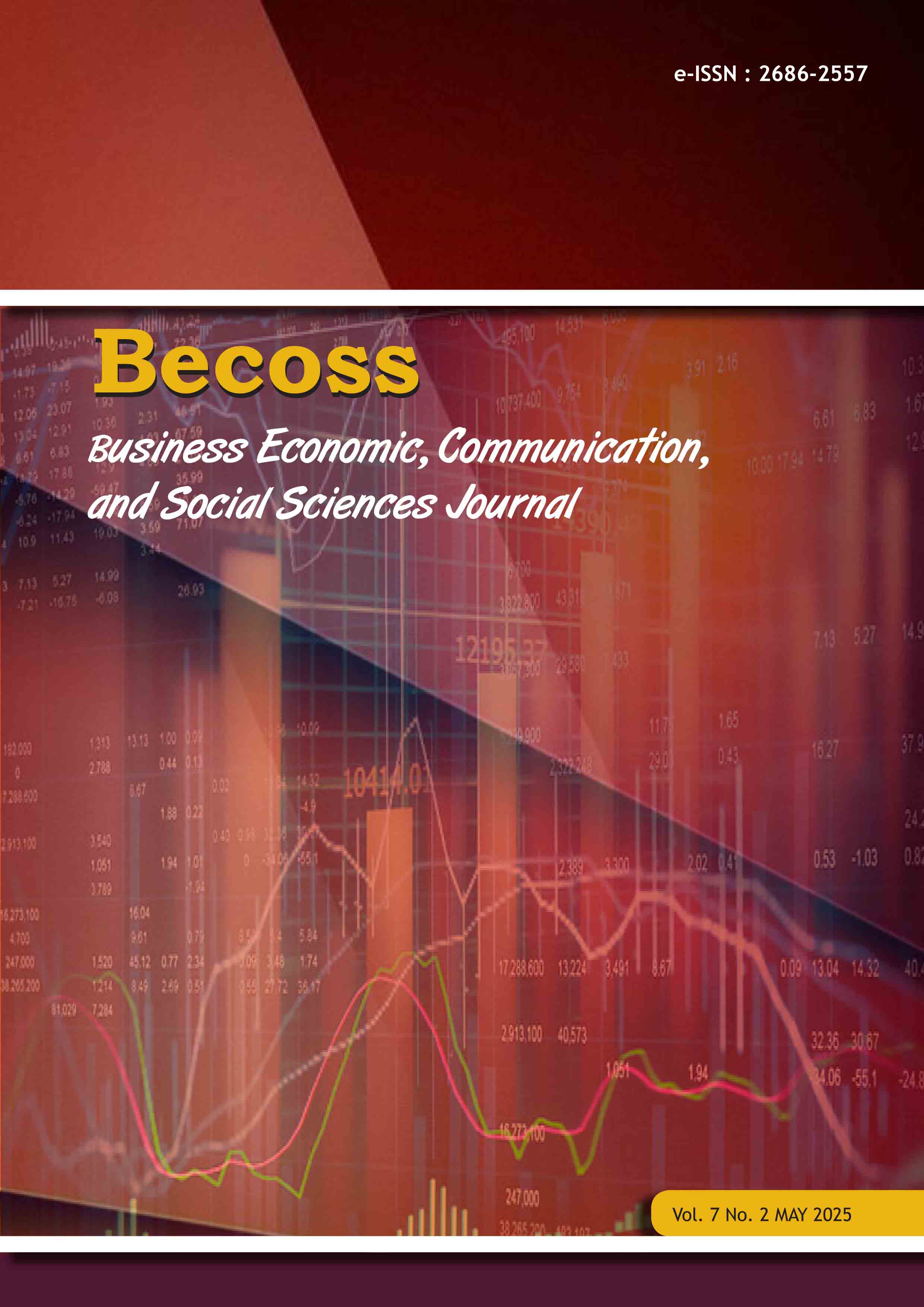A Measurement for Social Experience and Its Evaluation: A Case Study of University Student
DOI:
https://doi.org/10.21512/becossjournal.v7i2.13651Keywords:
Self-Efficacy, Self-Regulation, Social Experience, StudentsAbstract
Social experience refers to interactions and relationships that individuals have with others within their environments. According to researchers, higher levels of social experience can affect many aspects that an individual has, such as self-awareness, social skills, moral reasoning, intelligence, and emotional intelligence. Despite its importance, it is difficult to determine the valid and reliable measurement of social experience. The writer decided to create a survey as a measurement of social experience with 2 latent variables: self-efficacy and self-regulation to know the influence of both indicators on the measurement of social experience with 300 Bina Nusantara University students as its respondents. From the results of the survey, we conclude that verbal persuasion is the most impactful source from self-efficacy that influences social experience, while motivation is the most impactful source from self-regulation that influences social experience. All self-efficacy and self-regulation statements both are valid and reliable with convincing results. Although our results are convincing, it is essential to bear in mind that this study is not without limitations. These limitations include a limited sample size and the potential for biases in sampling and response due to the characteristics of our participants. Therefore, it is advisable for future research endeavors within this field to select participants from various universities and implement preliminary testing procedures to authenticate the survey.
References
Bandura, A. (1997). Self-efficacy: The exercise of control. New York, NY: W. H. Freeman.
Baumeister, R. F., & Vohs, K. D. (2007). Self-regulation, ego depletion, and motivation. Social and Personality Psychology Compass, 1(1), 115–128. https://doi.org/10.1111/j.1751-9004.2007.00001.x
Baumeister, R. F., Bratslavsky, E., Muraven, M., & Tice, D. M. (1998). Ego depletion: Is the active self a limited resource? Journal of Personality and Social Psychology, 74(5), 1252–1265. https://doi.org/10.1037/0022-3514.74.5.1252
Carver, C. S., & Scheier, M. F. (1981). Attention and self-regulation: A control theory approach to human behavior. New York, NY: Springer-Verlag. https://doi.org/10.1007/978-1-4612-5887-2
Carver, C. S., & Scheier, M. F. (1990). Origins and functions of positive and negative affect: A control-process view. Psychological Review, 97(1), 19–35. https://doi.org/10.1037/0033-295X.97.1.19
Check, J. W., & Schutt, R. K. (2013). Research methods in education. SAGE Publications.
Chipchase, L., Davidson, M., Blackstock, F., Bye, R., Colthier, P., Krupp, N., Dickson, W., Turner, D., & Williams, M. (2017). Conceptualising and measuring student disengagement in higher education: A synthesis of the literature. International Journal of Higher Education, 6(2), 31–42. https://doi.org/10.5430/ijhe.v6n2p31
Duran, R. L., & Kelly, L. (1994). The role of social experience in the development of communication competence. Communication Research Reports, 11(2), 119–126. https://doi.org/10.1080/08824099409359948
Faleeva, L., Ganieva, Y., Valeeva, R., Valeyeva, N., & Zakirova, V. (2017). Student’s social experience forming in university vocational training. Eurasian Journal of Analytical Chemistry, 12(7b), 1127–1135.
Hagger, M. S., Wood, C., Stiff, C., & Chatzisarantis, N. L. D. (2010). Ego depletion and the strength model of self-control: A meta-analysis. Psychological Bulletin, 136(4), 495–525. https://doi.org/10.1037/a0019486
Howse, R. B., Calkins, S. D., Anastopoulos, A. D., Keane, S. P., & Shelton, T. L. (2003). Regulatory contributors to children’s kindergarten achievement. Early Education and Development, 14(1), 101–120. https://doi.org/10.1207/s15566935eed1401_7
Joët, G., Usher, E. L., & Bressoux, P. (2011). Sources of self-efficacy: An investigation of elementary school students in France. Journal of Educational Psychology, 103(3), 649–663. https://doi.org/10.1037/a0024048
Leventhal, H., Leventhal, E. A., & Contrada, R. J. (1998). Self-regulation, health, and behavior: A perceptual-cognitive approach. Psychology & Health, 13(4), 717–733. https://doi.org/10.1080/08870449808407425
Narvaez, D. (2010). The emotional foundations of high moral intelligence. New Directions for Child and Adolescent Development, 2010(129), 77–94. https://doi.org/10.1002/cd.275
Prewett, S. L., Bergin, D. A., & Huang, F. L. (2018). Student and teacher perceptions on student-teacher relationship quality: A middle school perspective. School Psychology International, 40(1), 66–87. https://doi.org/10.1177/0143034318807743
Raskauskas, J., Rubiano, S., Offen, I., & Wayland, A. K. (2015). Do social self-efficacy and self-esteem moderate the relationship between peer victimization and academic performance? Social Psychology of Education, 18(2), 297–314. https://doi.org/10.1007/s11218-014-9285-x
Rubin, M., & Hewstone, M. (1998). Social identity theory’s self-esteem hypothesis: A review and some suggestions for clarification. Personality and Social Psychology Review, 2(1), 40–62. https://doi.org/10.1207/s15327957pspr0201_3
Schunk, D. H. (2012). Learning theories: An educational perspective. International edition, 6th ed. Upper Saddle River, Pearson.
Singleton, R., Jr., Straits, B. C., Straits, M. M., & McAllister, R. J. (1988). Approaches to social research. Oxford University Press.
South, L., Saffo, D., Vitek, O., Dunne, C., & Borkin, M. A. (2022). Effective use of Likert scales in visualization evaluations: A systematic review. Computer Graphics Forum, 41(3), 43–55. https://doi.org/10.1111/cgf.14538
Vehovar, V., Toepoel, V., & Steinmetz, S. (2016). Non-probability sampling. In C. Wolf, D. Joye, T. W. Smith, & Y. C. Fu (Eds.), The SAGE handbook of survey methodology (pp. 329–346). SAGE Publications. https://doi.org/10.4135/9781473957893
Waryanto, B., & Millafati, Y. A. (2006). Transformasi data skala ordinal ke interval dengan menggunakan makro Minitab. Jurnal Informatika Pertanian, 15, 881–895.
Downloads
Published
How to Cite
Issue
Section
License
Copyright (c) 2025 Felix Felix, Sharlene Regina, Margaretha Ohyver, Alexander Agung Santoso Gunawan, Heri Ngarianto

This work is licensed under a Creative Commons Attribution-ShareAlike 4.0 International License.
Authors who publish with this journal agree to the following terms:
- Authors retain copyright and grant the journal right of first publication with the work simultaneously licensed under a Creative Commons Attribution License - Share Alike that allows others to share the work with an acknowledgment of the work's authorship and initial publication in this journal.
- Authors are able to enter into separate, additional contractual arrangements for the non-exclusive distribution of the journal's published version of the work (e.g., post it to an institutional repository or publish it in a book), with an acknowledgment of its initial publication in this journal.
- Authors are permitted and encouraged to post their work online (e.g., in institutional repositories or on their website) prior to and during the submission process, as it can lead to productive exchanges, as well as earlier and greater citation of published work.
USER RIGHTS
All articles published Open Access will be immediately and permanently free for everyone to read and download. We are continuously working with our author communities to select the best choice of license options, currently being defined for this journal as follows: Creative Commons Attribution-Share Alike (CC BY-SA)






